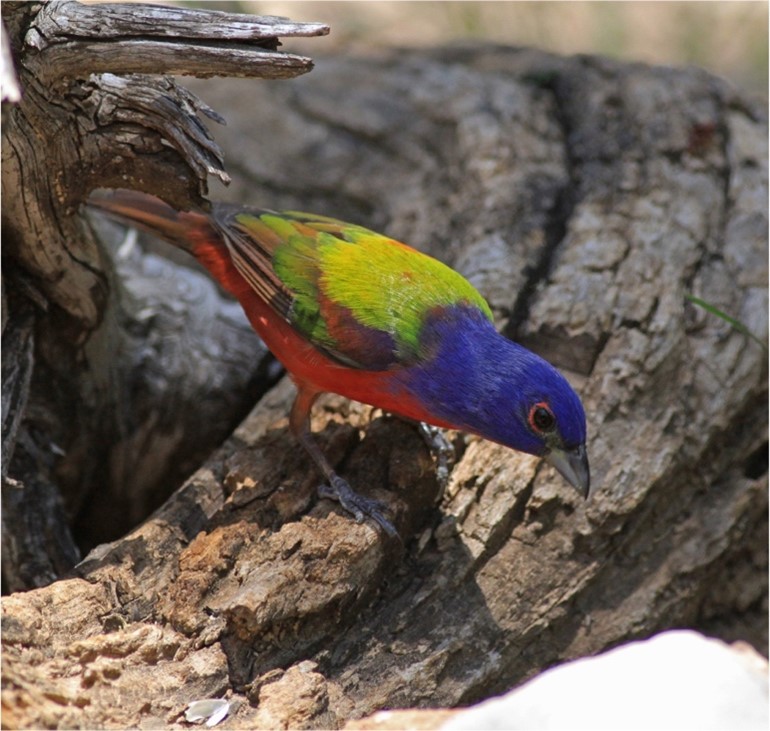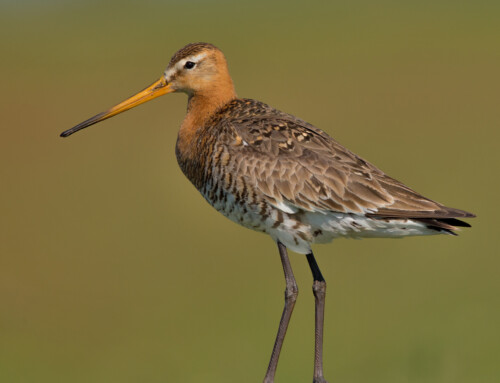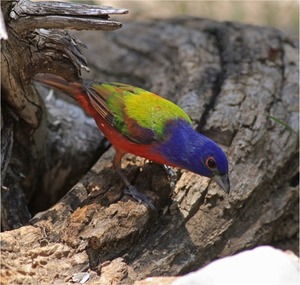 LINKED PAPER
LINKED PAPER
Short term weather patterns influence avian body condition during the breeding season. McCloy, M.W.D. & Grace, J.K. 2023 Frontiers in Ecology and Evolution. doi: 10.3389/fevo.2020.1154656 VIEW
An enormous amount of research has focused on how birds are projected to respond under various future climate scenarios (Langham et al. 2015). However, most of this body of literature investigates the effects of long-term climate trends while the effects of short-term weather on individual body condition are less established. These short-term effects are no less important since poor body condition has been associated with declines in individual fitness for many avian species, which may result in altered population productivity. Previous studies have established body condition as a frequently used physiological indicator and that it can be affected by a variety of environmental variables (Gardner et al. 2016).
We investigated how monthly temperature and precipitation changes affected the body condition of birds at both a regional and a local level largely using data from the Monitoring Avian Productivity and Survivorship (MAPS) programme across the southeastern United States (DeSante et al. 2015). Specifically, we used data from a 15-year period across 79 sampling sites in states bordering the Gulf of Mexico because of this region’s likely susceptibility to extreme future climatic events (Reece et al. 2018). Instead of focusing on a single species in our analysis we decided to take a multi-species approach and compare any patterns that emerged across species. In doing so, we analysed body condition for 18 passerine bird species which were chosen based on a combination of sample size and/or conservation concern.
Another important decision we had to make was how to actually calculate “body condition”. Numerous methods of doing so exist in the literature and range from simple to complex. We ended up using the popular scaled mass index (Peig and Green 2007), which is calculated from body mass and morphometric (in this case, wing length) values and accounts for changes in the relationship between these values over time. With body condition values calculated for each individual of the target species analysed we then used Generalized Additive Models and a model selection approach to understand the effects that monthly temperature and precipitation were having on each species. We also ran models on guilds, or groupings of similar species based on habitat, dietary preferences, and migratory status to further understand any patterns that may emerge.

Figure 1 Partial effect of average daily maximum temperature (degrees Celsius) on scaled mass index for six species. Left: Carolina Chickadee (CACH, top), Northern Cardinal (NOCA, center), Tufted Titmouse (TUTI, bottom); right: Hooded Warbler (HOWA, top), Carolina Wren (CARW, center) and White-eyed Vireo (WEVI, bottom).
Some of our main findings were that the responses of avian body condition to weather variables were largely nonlinear and could vary by species. Interestingly a threshold effect was evident for many species, after which the relationship between body condition and weather changed drastically. As an example, body condition tended to increase with daily maximum temperature but only until approximately 25 degrees Celsius (Figure 1). With average daily minimum temperature we noticed a similar phenomenon around 10 degrees Celsius, after which point the effect of this variable appeared negated (Figure 2). Many species also showed a positive relationship with precipitation but after only 10-20 cm monthly (Figure 3). As precipitation and temperature patterns continue to be altered with climate change, species may be pushed further towards or away from these thresholds. The fact that non-linear effects were also highly species-specific and not easily explained by expected effects on food availability indicates that avian responses may be difficult to predict across species.
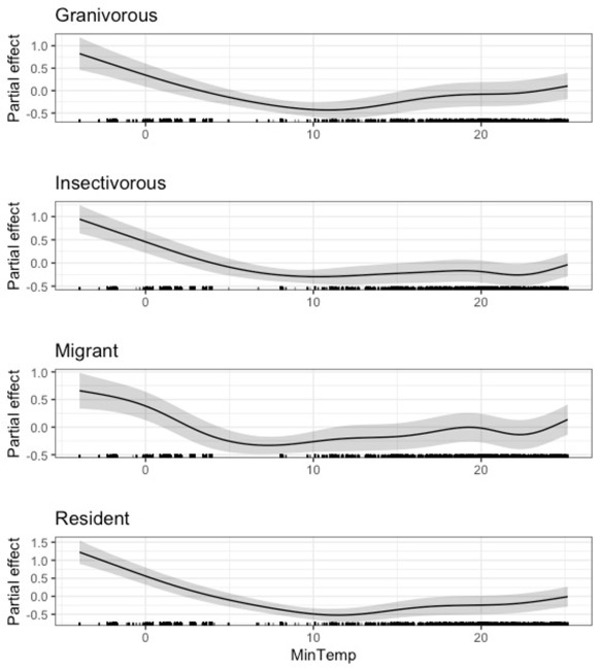
Figure 2 Partial effect of average daily minimum temperature (degrees Celsius) on scaled mass index for the granivorous guild (top), insectivorous guild (second from top), Neotropical migrant guild (third from top), and resident guild (bottom).
We also used a similar approach to better understand how the short-term effects of temperature and precipitation manifest on a local level. Our study site was the Welder Wildlife Refuge near Rockport, Texas, USA where Hurricane Harvey made landfall in August 2017 as a powerful Category 4 storm. Long-term morphometric data was available for this location, also through the MAPS programme (DeSante et al. 2015), which allowed us to analyse 13 years of data spanning from 2007-2019. This was a unique opportunity to investigate annual changes pre- and post-hurricane since few prior studies have analysed avian body condition within the context of an extreme weather event such as this.
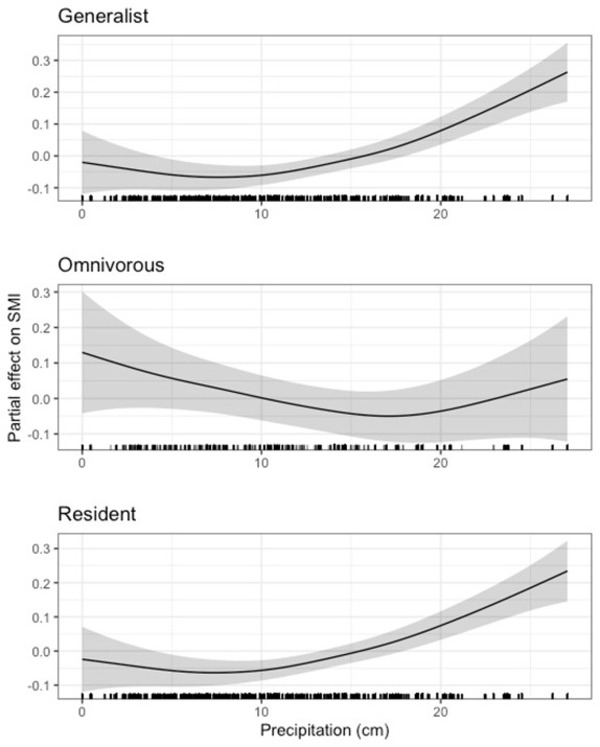
Figure 3 Partial effect of precipitation on scaled mass index for the habitat generalist guild (top), the omnivorous guild (center), and the resident guild (bottom).
Again using an array of additive models we examined the relationship between body condition (with scaled mass index) and daily maximum temperature, daily minimum temperature, and monthly total precipitation for three passerine bird species including the Northern Cardinal (Cardinalis cardinalis), Painted Bunting (Passerina ciris) and White-eyed Vireo (Vireo griseus). Additionally, we evaluated yearly changes in body condition for these species over a 12-year period, focusing on the extreme precipitation event of Hurricane Harvey which caused heavy localised flooding.
We found that body condition declined with average daily minimum and maximum temperatures, while precipitation had varied, species-specific effects. Our results also suggest that Northern Cardinals experienced a notable reduction in mean body condition in the two years following Hurricane Harvey. This indicates a potential for future extreme weather events to have standalone, negative effects on avian body condition which can also have population-level implications.
When synthesising the results of these two studies in tandem, we can conclude that even short-term changes to temperature and precipitation patterns have the potential to noticeably impact the body condition of passerine species. It’s also important to note that although the magnitude of these effects may differ between species, the implication for how birds may respond to future climatic shifts is real and negative consequences may begin to manifest sooner that we originally thought.
Interested in more? Read Michael’s new paper on local weather effects on the body condition of three North American songbird species here (McCloy et al. 2023).
References
DeSante, D. F., Burton, K. M., Velez, P., Froehlich, D., Kaschube, D., & Albert, S. 2015. MAPS manual, 2015 protocol. Point Reyes Station, CA: The Institute for Bird Populations. 1–85.
Gardner, J. L., Amano, T., Sutherland, W. J., & Clayton, M. 2016. Individual and demographic consequences of reduced body condition following repeated exposure to high temperatures. Ecology 97:786-795. VIEW
Langham, G. M., Schuetz, J. G., Distler, T., Soykan, C. U., & Wilsey, C. 2015. Conservation status of north American birds in the face of future climate change. PLoS One 10:1-16. VIEW
McCloy, M.W.D., Glasscock, S., & J.K Grace. 2023. Local weather affects body condition of three North American songbird species on the Texas coast. Ecology and Evolution. VIEW
Reece, J. S., Watson, A., Dalyander, P. S., Edwards, C. K., Geselbracht, L., LaPeyre, M.K., Tirpak, B.E., Tirpak, J.M. & Woodrey, M. 2018. A multiscale natural community and species-level vulnerability assessment of the Gulf coast, USA. PLoS One 13:e0199844. VIEW
Image credit
Top right: Painted Bunting (Passerina ciris) © Michael McCloy.
If you want to write about your research in #theBOUblog, then please see here.


